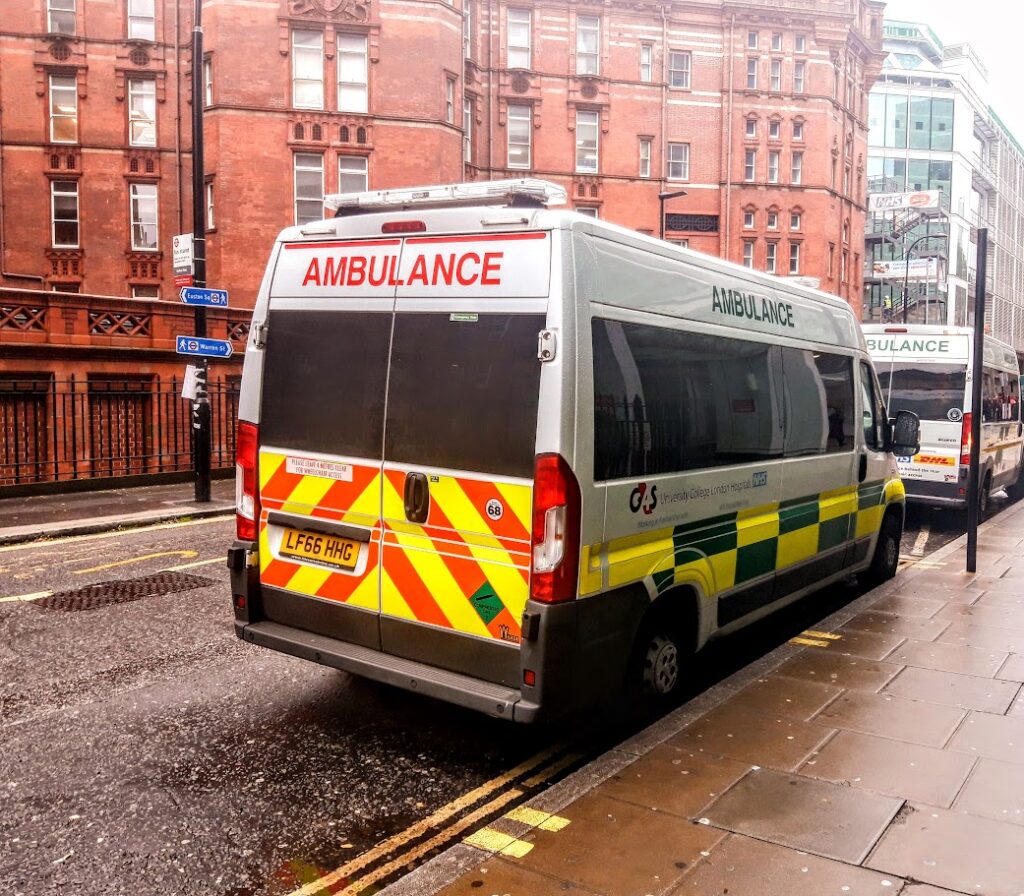Video streaming from ambulance can be life-changing for acute stroke patients

An ambulance — Image by © Tim Sandle.
When someone suffers a stroke, time and choice of treatment are critical factors. The outcome largely depends on how quickly the person receives the right care. If the ambulance staff can consult a stroke specialist via video streaming inside the ambulance, before departure, lives can be saved and permanent brain damage prevented.
This is shown in a study led by Chalmers University of Technology, in Sweden, which involved key professional groups required when someone suffers an acute stroke.
“Using video streaming and consultation in the ambulance, stroke patients can quickly and remotely be assessed by a neurologist and driven directly to the hospital that can provide them with the best care. The biggest difference can be felt by the people who live furthest away from a specialist hospital. So, in addition to better care outcomes, this means more equal care for each stroke patient,” Stefan Candefjord tells MedicalXpress.
Stroke is a collective name for diseases caused by a blood clot (infarction) or a haemorrhage in the brain. About 85 percent of the cases are infarctions. Every year, about 6 million people are affected in the world, and in Sweden, according to the National Quality Register for Stroke Care, there are about 25,000 people.
The right decision can save one and a half hours
A stroke is mostly caused by a clot in the blood vessels of the brain. In the case of clots in smaller blood vessels, clot-dissolving drugs, known as thrombolytics, are normally given at a nearby emergency hospital. However, in the case of clots in the larger vessels of the brain, significantly better results are achieved if the blood clot can be removed through a surgical procedure – thrombectomy.
This involves entering a blood vessel that leads into the brain and mechanically pulling out the clot with the help of a catheter. Since this is quite a complicated procedure, it can only be performed at specialist hospitals.
Regardless of the treatment needed, a CT (computed tomography) image examination of the brain is initially done at hospital to assess the situation and the type of stroke. If the patient has been transported to a nearby emergency hospital, further transport is then usually required to be able to offer thrombectomy – if this is deemed to be the optimal treatment.
“A decision in the ambulance to transport a patient directly to Sahlgrenska University Hospital is estimated to save one and a half hours in processing time for patients who live outside Greater Gothenburg. This can be a life-changing timesaving for those who need a thrombectomy, as an hour’s delay is estimated to halve the effect of the treatment. Every year, a significant number of people could have a completely different life if they had a thrombectomy faster,” adds Bengt Arne Sjöqvist, Professor Emeritus of digital health.
The researchers behind the study point out that it is important to identify as early as possible, and with high precision, which patients need which care. With the video streaming support, it is possible to enhance an existing care process for selected patients, which is currently based on telephone calls between ambulance personnel and specialist doctors.
Realistic full-scale simulations
To test and evaluate how a video-assisted decision support system can work in practice, realistic full-scale simulations were conducted. Four ambulance teams received alerts about people with stroke symptoms of varying severity. The patients were played by neurologists and the ambulances were equipped with three cameras that were connected to stroke specialists at Sahlgrenska University Hospital in Gothenburg.
The first camera focused on the patient’s face, so that an assessment of facial expressions, as well as head and eye movements could be made. The second camera was angled towards the side of the patient, to give a general overview and assess the ability to lift and hold up their arms. Finally, a third camera showed the patient’s legs, to make a similar assessment as for the arms.
Continued work to introduce technology as normal routine
After the simulation study, a clinical pilot study was carried out with three ambulances and actual stroke patients, in a region outside of Gothenburg – Södra Älvsborg. The pilot study was successful, and the results and experiences where transferred to Region Västra Götaland , the responsible healthcare stakeholder, as part of its investment and promotion of increased healthcare digitalisation.
“With the primarily responsible stakeholder as project lead, the intention was to manage a critical phase in utilisation as well as regional adaptation, deployment and future form of operation, a work that is still ongoing. Of course, we hope that the positive results from our work will soon be shared by patients, and then also in other places. Disseminating and sharing our results and experiences, as well as helping everyone who wants to test and implement, is important to us,” says Bengt Arne Sjöqvist.
Research paper
The study “Video support for prehospital stroke consultation: implications for system design and clinical implementation from prehospital simulations” is published in BMC Medical Informatics and Decision Making.
Video streaming from ambulance can be life-changing for acute stroke patients
#Video #streaming #ambulance #lifechanging #acute #stroke #patients





